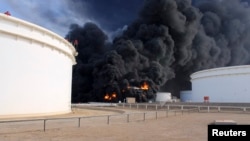Libya's foreign minister warned Sunday that a coalition of extremist groups is making a push to seize the troubled country's oil resources, after an assault on eastern terminals set storage tanks ablaze, destroying 800,000 barrels of crude.
A missile hit an oil storage tank last week at the port of Es Sider during fighting between forces allied to Libya's two competing governments, resulting in the destruction of more than two days' worth of the country's oil production, officials said on Sunday.
Foreign Minister Mohamed al-Dairi, speaking in Cairo, said the assault was carried out by militias based in the western city of Misrata and loyal to the rival Islamist-backed government in Tripoli.
Dairi said extremist groups have joined the attack, which forced a shutdown of the country's largest shipping terminal.
Retaliation
In an apparent response to the attack on Es Sider, forces loyal to Libya's recognized government staged airstrikes on targets in the western city of Misrata Sunday.
Mohamed El Hejazi, spokesman for armed forces loyal to the internationally recognized government, said the airstrikes hit an air force academy near the airport and Libya's biggest steel plant, which is located in the city.
The raids were the first such attacks on a city allied to the Libya Dawn militia group that seized Tripoli, and whose forces have been trying to take the eastern oil ports from the internationally recognized government, officials and residents said.
A security official in Misrata said the airstrikes hit near the airport, with one missile striking 300 meters from an airport tower but missing the tarmac.
There were no immediate reports of casualties.
Ismail Shukri, spokesman for forces allied to Libya Dawn, confirmed that airstrikes had taken place but said they caused no damage.
Libya has been engulfed in fighting between the two sides, each with its own government and parliament and each anxious to secure a share of Africa's largest oil reserves.
The internationally recognized Prime Minister Abdullah al-Thinni has been forced to run a rump state in the eastern city of Tobruk since the Libya Dawn group took control of Tripoli in August, setting up a rival government and parliament.
Attack on port facilities
Es Sider and the adjacent Ras Lanuf terminal have been closed since a force allied to Libya Dawn moved east from the capital two weeks ago in an attempt to seize the facilities. On Thursday, the group killed at least 22 soldiers in a surprise attack by speedboat.
Dairi, the foreign minister for the Tobruk government, said extremists, some of whom have pledged allegiance to the Islamic State group, have expanded their presence in Libya, including to the capital.
“We as Libyans are concerned. But the Arab world and the international community should be too because of the desire of these extremist terrorist groups to reach oil resources and revenues. This is a dangerous matter,” Dairi said at a joint news conference with his counterpart, the foreign minister of ally Egypt.
U.N.-sponsored talks between the rival governments are scheduled for Jan. 5.
The U.N. Support Mission in Libya condemned the airstrikes in Misrata.
Fires still burning
A National Oil Corporation spokesman said three oil storage tanks at Es Sider were still on fire on Sunday, while fire-fighters had managed to extinguish the blaze at three other tanks.
Libya's total oil production stands at 385,000 barrels per day, the NOC said.
Since Moammar Gadhafi was ousted in 2011, Libya has failed to attain stability. Former rebel brigades, which once fought side by side, have now turned on each other, aligning themselves with rival political factions in a scramble for control.
Material for this report came from Reuters, AP and AFP.









